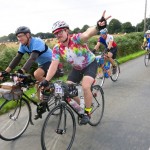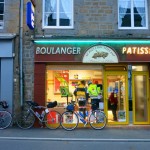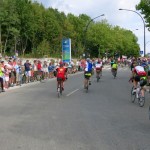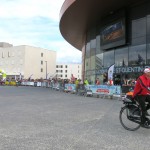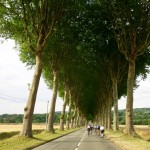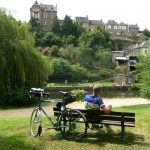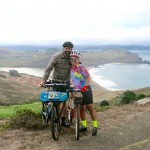Paris-Brest-Paris: 1230 kilometers ridden in less than 90 hours. How does one even begin to capture the drama, the beauty, the hardships and triumphs of cycling this distance in that time frame? It’s an artistic undertaking that’s almost as daunting as the ride itself. Countless articles, blog posts, essays, photographs and videos have already chronicled Paris-Brest-Paris in depth – but here is my humble contribution to my predecessors’ narratives.
PROLOGUE
My ride reports will be different from the previous ones on my blog as I’m taking a thematic approach vs. chronologically recounting each day’s events. They’ll be broken down into the following seven categories: Cyclists; The Bicycles; the French; Architecture; Landscapes; Food, Glorious, Food; The Highs, The Lows and The Highs. I’m also going to gloss over the history of Paris-Brest-Paris; you can find an excellent summary at the Randonneurs USA website if you’d like to learn more about the origins of this time-honored endurance event.
When did Paris-Brest-Paris first appear on my radar? My initial curiosity was sparked back in 2013 during my very first 300k, when my friends Bill, Tom and Steve helped me get through a (tough for me) portion of the ride. As evening fell and my energy waned in the latter part of the brevet, they told me inspiring stories of their adventures abroad and painted a rather romantic portrait of PBP. While we’d never race as professionals in the Tour de France, this was the next best thing in a way: an amateur version with crowds cheering you from the roadside while you ate delicious pastries and crossed the French countryside from east to west. I’m not sure what attracted me more – the allure of participating in a prestigious historic event or the promise of a rolling buffet of gourmet cuisine (I’m equally enthusiastic about food as I am about cycling) – but a tiny flicker of interest was ignited that night. At that point, however, I was just trying to survive my first super randonneur series; Paris-Brest-Paris was still a far-off dream, a fanciful folly that I wouldn’t seriously consider until the following year.
THE CYCLISTS
Fast-forward to the present day of August 2015: the 18th edition of Paris-Brest-Paris was upon me. I’d been bitten by the PBP bug and had completed three full series and earned a RUSA cup since embarking on my randonneuring journey nearly three years ago. I was absolutely thrilled to have qualified and registered — I was going to France! The niche aspect of this sport became more apparent after I conducted a little research about the event and gleaned a few notable facts from the official pamphlet. Just 26,515 riders have been awarded a PBP medal since 1931. And back in 2011, only 300 women began the ride, with just 208 finishing successfully. I’d be joining the rarefied ranks of other female riders, which I hoped would be increasing this year, along with close to 6000 riders from 60 countries around the world.
Downtown St. Quentin-en-Yvelines, the start of the ride, was the lively hub of pre-PBP activity. For the next week or so, the streets of this small Parisian suburb – which was merely 40 years old, unlike this event that dated back over a century – were filled with a peaceful mob of cyclists who monopolized its shops and eateries, stacking their bicycles in deep rows on the sidewalks. It actually felt more normal to clack around in cleated shoes and don spandex in public for a change; our unique clan, costumed in our stretchy colorful kits, far outnumbered the civilian customers dining at cafés that lined the main drag.
click images to enlarge
The Mercure and Campanile hotels were the preferred accommodations for the American contingent and became the busiest stateside social centers by default. Scores of unwieldy bike boxes were piled onto precarious pyramids in cramped storage rooms while bikes were methodically assembled out front. Randonneurs reconnected with old friends from across the U.S., chatting in the lobbies and restaurants or heading out together for short group rides to shake out their legs before the big day.
Nothing prepared me for the overwhelming, frenzied energy of the local velodrome on registration day. It was a veritable United Nations of cyclists; this was when it truly sank in that this was our Olympics, our signature event where we proudly converged in solidarity of our international randonneurhood. But a checklist of formalities had to be attended to before we could socialize — getting our bikes inspected, receiving paperwork, timing chips, jerseys, vests and other memorabilia — which also served as a preview of the long lines that awaited us on the course.
With the necessary PBP business out of the way, we focused on the fun part of the afternoon: taking and posing for photos on the velodrome grounds. I greeted old friends — swapping pins and hugs — and introduced myself to new comrades as I snapped away with my camera. I also reunited with members of my home club, the San Francisco Randonneurs (which had the largest American representation at the event with 70 riders) and the national team of Randonneurs USA for group photos. I’m fairly certain the Chinese and Brazilians won the spirit awards, as they heartily chanted and sang during their portraits. While milling about the crowds, I was sometimes mistaken for a member of the Japanese team — especially since the RUSA jersey somewhat resembled this year’s official PBP garb — except by the Japanese themselves, who were tastefully clad in the most stylish custom kits at the event.
The vibrant parade of nationalities commenced at the departure of the 80-hour and 90-hour groups and continued on the road. (The 84-hour group embarked the next day.)
I was surprised by how much individuals from their respective countries tended to stick together — both on and off the road. Most likely it was due to language barriers and finding comfort in familiar company. Me and my riding partners would glom on whenever we could to pacelines, but some riders were poorly versed in road etiquette. There were instances when they’d pass on the right, or cut through the middle of a pack to breakaway from the group or form irregular, messy pelotons. They wouldn’t say hello or offer up any niceties; it was all business on the bike. It was usually easier to stick with one’s cycling colleagues than to try and negotiate the varying riding styles of other participants — especially when fatigue set in.
Some other small cultural differences I discovered were based on native vernacular: the Brits yelled out, “Rails!” instead of our “Tracks!” when encountering railroad crossings. Sometimes they’d also say, “Car up!” (instead of our “Car back!” when vehicles were behind us), or “Car down!” (in reference to cars approaching from the front.) Many other groups wouldn’t say anything at all.
Chugging away on the road for hours, I had plenty of time to see how other riders were equipped. Some wore giant backpacks (I couldn’t understand how that was physically possible), others had panniers and a few brought barely anything at all; I presumed they must have support vehicles, which is how they stayed so fresh-looking throughout the ride. One friend told me he passed by a camper and saw a woman frying eggs for their team as they relaxed in lawn chairs (so jealous); another said he saw a few helpers swapping out lighter bikes for their riders towards the end so they could have a faster finish (which pissed him off and goaded him to continue despite the fact he was contending with some tough injuries.) Ah well, I suppose there’ll always be a few folks who’ll bend the rules a bit.
While I didn’t click with as many riders outside of the U.S. as I’d hoped, I did forge many new friendships with quite a few Americans that I rode with all throughout PBP (and have a greatly expanded pin collection as a result). It was wonderful to finally put some real faces to the internet usernames that I’d only seen on Facebook or Google groups or other social media. Wearing my SF Randonneurs jerseys for much of the ride was a fine calling card that advertised my provenance; people would just greet me with, “Hey, California!”




